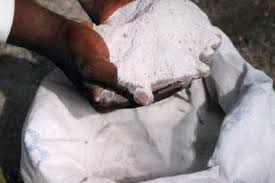
The chronically acidic soils of Western Kenya has meant endless woes to the farmers in the area, but a new method of applying lime to the tired soils is changing fortunes and rekindling hope to thousands of farmers who had abandoned farming. In 2008, Isaac Ochieng Okwangi from Nyangera, Siaya District harvested just two 90kg bags of maize from his one and a half acre maize plot. On the same piece of land today, 29-year-old Ochieng gets around 16 bags a season, in two seasons a year. His yields from other crops like beans have also risen.
Ochieng attributes the eight-fold rise to applying lime on his farm, which lowers soil acidity to levels that sustain subsistence crops, according to David Mbakaya a soil scientist with the Kenya Agricultural Research Institute (KARI) in Kakamega.
According to a recent report by AGRA-Alliance, Kenya has over half a million hectares of acidic soils in its maize growing areas. In Western Kenya, around 57,670 hectares of soil are acidic. The use of nitrogenous fertilizers like DAP and high rainfalls that penetrate deep into the ground have exacerbated the problems of soil acidity.
Year in, year out subsistence farming without rotating crops has also increased soil acidity, giving the land “no rest.” As a result, maize yields in Western Kenya are on average estimated at less than 1 tonnes per hectare, yet neighboring regions get 5 to 6 tonnes a hectare.
In 2009, acting on advice from KARI Kakamega, Ochieng applied on his one and a half acres 10 bags of agricultural lime. He was one of 50 farmers who got the lime for free when Alliance for Green Revolution (AGRA) sponsored KARI led trials that provided the lime, costing Sh270 a bag of 50kgs from the Homalime Factory in Koru, Kisume.
After Ochieng spread it on his maize plot, he cultivated it into the soil, planted his maize and waited for the results. “The maize was vibrant and one maize plant would have two or more cobs,” he said.
Although he bypassed the Sh2700 cost of adding the lime, the returns would have made the investment worthwhile even if he had paid. In both 2010 maize seasons he harvested 16 bags each season, fetching a market price of Sh5000 a bag. He also sold 4 sacks of beans each earning Sh8000.
The Sh2700 in the right input had shifted his annual earnings from what would have been Sh20,000 to Sh112,000. Ochieng even sold some of his maize to other farmers who had poor harvests after declining to apply lime on their land. With the proceeds he was able to build a new house for his family of two children.
His turnaround has since convinced other local farmers to dig lime in. “We had no hunger,” said 33-year-old Evelyn Achieng Ochieng, another of the 50 members who applied lime in 2009. Before, she used to get 3 or at most 4 bags of maize from her half an acre plot. Now she gets 10. The change saw Achieng also try it on her cassava plantation, where the cassava became vibrant and leaves wouldn’t sag. “It’s like they got rid of some cassava disease,” she said.
A near similar observation was made by Stanley Chiveti, a nursery tree farmer who says applying lime matures his tree seedlings faster. Initially, they would reach certain heights at 6 months. Now they get there in 4 months and without nursery tree pests.
According to Mbakaya, soils they have sampled in Western Kenya have PH levels of 4.3 to 5.5. Yet subsistence staple crops thrive at a PH of 5.5 to 6. KARI supervises farmers applying lime to ensure they don’t put in too much and make the soil to alkaline. Alkaline soils only work well for tea farming.
After one full application of lime, KARI advises farmers to reapply the lime again after 3 years. “Over applying lime leads to toxicity,” said Mbakaya.
When applying lime on soil, he also advises farmers to have gloves and face masks as it irritates the skins and chokes. In the soil, lime replenishes Magnesium and Calcium minerals.
Lime is also being added to fish ponds by fish farmers like Francis Sakula from Isanjiro Village in Northern Kakamega. In his 50ft by 50ft pond with over 1000 tilapia he applies the lime to stop the green algae (spirogyra) from forming and floating on his fish pond denying his fish oxygen. It also kills frog tad poles ,which prey on fish fingerlings and encourages growth of the water plants that fish feed on.
In addition, frogs don’t lay eggs in limed water and snakes don’t invade a pond with lime. Its brownish color when applied to the ponds also obstructs the view of birds that prey on fish. Sakula applies around 5kg to 10kg of lime from the pond’s inlet.
Farmers like Ochieng and Achieng who got the lime for free will now have to buy and reapply it after 3 years. In Western Kenya there are 5 Agro-Dealers stocking the agricultural lime, but AGRA is currently paying for transport in an effort to keep the lime affordable.
The research into the impact of applying lime was done by KARI Kakamega and Moi University Eldoret after they got a grant from AGRA’s Soil Health Programme.
For Isaac Ochieng, the study has transformed his life. In early 2008, he left Nairobi’s Mathare area with just Sh7000, having lost all his possessions to arson in the post election violence. Today, he has no regrets as he gazes at his lush vibrant maize crops and the vegetables he is growing, and has emerged as an outspoken advocate for the benefits of lime for the farmers in his region.

















Comments powered by CComment